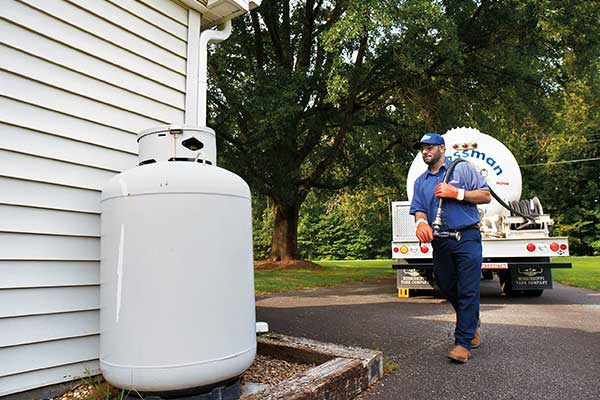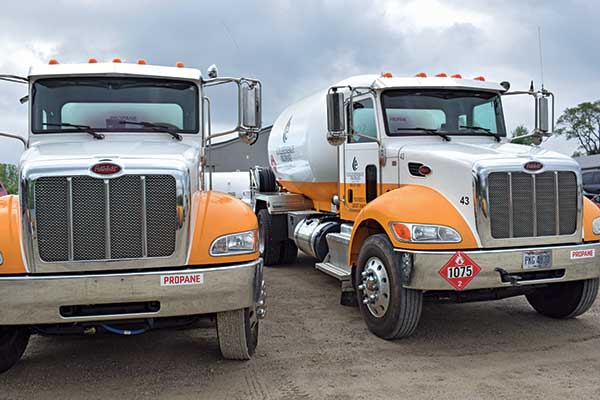Apprenticeship program aims to grow propane industry workforce

Attracting younger generations to careers in propane is a key goal of the apprenticeship program. Photo courtesy of Blossman Gas
The propane industry has been described as “aging,” particularly when it comes to the industry’s drivers.
The Propane Education & Research Council (PERC) and the National Propane Gas Association (NPGA) have made workforce development a key priority in recent years, says Mike Caldarera, senior vice president of advocacy and technical services at NPGA, noting that the median driver age in the propane industry is about 55 years old – almost 15 years older than the U.S. workforce median age of 41.9, per the U.S. Bureau of Labor Statistics.
“Several years ago, the industry asked us to look at and put a greater emphasis on the area of workforce development and recognize that this was an issue that really confronted the whole industry,” Caldarera says.
One viable option NPGA identified to help accelerate workforce development was industrywide adoption of a registered apprenticeship program. One goal of adopting such a program would be to bring more young people into the industry, create livelihoods for them and set them on a long-term career path in propane.
In fact, someone who has completed an apprenticeship program, on average, makes $300,000 more in lifetime earnings than someone who did not learn skills through such a program, according to Jim Foti, regional director at the U.S. Department of Labor, during an NPGA webinar on the topic of apprenticeship.
“It connects with our human capacity to learn and also with our earnings capacity as we move forward,” Foti says.
NPGA, in collaboration with PERC and the Department of Labor, launched that apprenticeship program on April 15. Because NPGA already works closely with government agencies, it was named the administrator of the program. The association worked with the Department of Labor for several years to lay the groundwork and requirements of the program.
“It would be beneficial to create a program that had some rigor to it or a certain set of third-party standards, which is why we approached the Department of Labor to basically get our program registered with their office of apprenticeship,” says Caldarera, who is NPGA’s lead staff member for the program’s oversight.
Pathways and requirements
In addition to a propane service technician pathway, the apprenticeship program offers three pathways for commercial motor vehicle driver apprentices: bobtail driving, transport driving and utility and service truck driving.
Rather than simply logging hours, NPGA’s program is built on the concept of competency-based apprenticeships, meaning an apprentice must exemplify proficiency in a certain number of skills related to the job before moving on.
Each pathway requires completion of a different number of core competencies during the apprenticeship.
For example, a bobtail driver apprenticeship consists of 50 core competencies such as loading and unloading bobtails; safely handling hazardous materials; injecting methanol and evacuating containers, according to NPGA.
The utility and service truck driver apprentices must complete 44 core competencies. Among those are the abilities to fill and deliver containers; handle accidents and emergencies; and inspect, identify and document vehicles.
Meanwhile, the transport vehicle driver apprenticeship includes 56 core competencies, including identifying components of terminal and bulk plant loading and unloading systems; unloading a transport in a non-metered delivery service; and performing monthly tests of transport and hose assemblies.
A competency-based program offers benefits to both the apprentice and the employer, NPGA says. It allows apprentices to work at their own pace, which offers them flexibility and the ability to meet their core competencies more quickly than a traditional hours-based program, if needed.
On the employer side, a competency-based apprenticeship program offers retailers peace of mind that their apprentices have truly mastered the requirements of the job – particularly in an industry where safety is paramount.
“It gives confidence and assurance to the employer, especially if the apprentice can perform those jobs consistently and do it properly,” Caldarera says. “It conveys to the employer that, ‘Okay, we’ve got a quality person here, and we’ve invested the time in them. This is someone that we know we can send out to do a job.’”
While the employer confirms that the apprentice has mastered the core competencies, Caldarera encourages both the apprentice and employer to take their time throughout the process to reap the maximum benefits and take the extra steps to mold a career path for the individual.
“Apprenticeships are building careers, so these programs are not a sprint,” he says. “They are basically long-term programs, a commitment by the apprentice and commitment by the employer.”

Pathways include bobtail, transport, and utility and service truck driving. Photo by LP Gas staff
Partnering with NPGA
Propane retailers can find all necessary forms to enroll in the apprenticeship program through the association’s website (npga.org).
NPGA requires the information of both the employer and apprentice upon registration to contribute to a dedicated database that tracks everyone participating in the program. Throughout the partnership, the association says it maintains all records and serves as the point of contact with the Department of Labor, submitting all reports as needed.
NPGA does not hire apprentices but rather serves as a partner with the propane retailer to help it complete the process. However, the association says it will do what it can to match an employer with an apprentice when there are two interested parties in the same area.
Among other requirements, all apprentices must be at least 21 years old, eligible to work in the U.S., have proof of a high school diploma or GED and be able to obtain a commercial driver’s license prior to completion of the apprenticeship program.
Once the employer and apprentice are both enrolled, it is the employer’s responsibility to enforce the core competencies, using them as a guide for the apprentice’s learning track.
Additionally, employers should establish benchmarks at periodic time frames for each apprentice to determine progress, and apprentices should earn compensation increases as they progress through the program – including at least one pay increase within the first six months of starting the program, NPGA says. The retailer determines the wage scale but must start at least at minimum wage, according to the association.
A long-term investment
While the program requires investment on the employer’s end, Caldarera reminds propane retailers that participating in apprenticeship programs is quite beneficial in the long run. Choosing the apprenticeship route often results in greater employee retention, he says. In fact, 94 percent of apprentices retain employment after completing their programs, according to the Department of Labor.
“Almost always, the individual reciprocates that when they complete the program by staying with the employer, where they see that there’s a potential career path, as opposed to just simply a job,” Caldarera says.
From an industry perspective, bringing in members of the younger generations as apprentices can solidify their career paths and show them what the industry has to offer. In turn, it can help the industry stay competitive and grow a more robust future.
“The need to appeal to younger people to get them into the industry and get them onto a career path is really paramount,” Caldarera adds. “Hopefully, this apprenticeship program can start people down that path and hopefully provide them a career path but [also] increase opportunities for people in the industry.”
















